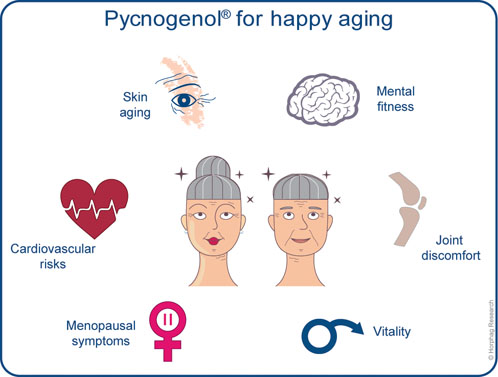Let’s face it, we’re not as physically or mentally fit as we used to be. And although this merely reflects the normal course of life, we still want to enjoy it to its fullest. We want a fresh new start of the year and embrace ageing as happily as possible.
The World Health Organization has declared the years between 2021 and 2030 to be the United Nations Decade of Healthy Ageing.1 The goal of this global collaboration is to “improve the lives of older people, their families and the communities in which they live.”
There are more than one billion people worldwide who are older than 60 and, with life expectancies rising, more and more efforts are needed to ensure that the ageing process is a happy and healthy one.
Evidence of the beneficial impact of Pycnogenol® French maritime pine bark extract in the elderly is supported by a significant number of scientific publications. Thanks to its unique composition, which includes polyphenols and their metabolites, Pycnogenol can exert a wide range of positive effects on our body (Figure 1). Those effects comprise
- reducing cardiovascular risk2–20
- limiting skin ageing21–30
- enhancing mental fitness31–34
- decreasing joint discomfort35–38
- relieving menopausal symptoms6,39–41
- improving the health problems of ageing men.12,13,42–45
Pycnogenol improves cardiovascular risk factors
Cardiovascular disease affects a large number of ageing people; 50% of women aged 65 and older, and 70–80% of similarly aged men, suffer from coronary artery disease.46

An ever-increasing number of clinical studies demonstrate the efficacy of Pycnogenol to improve cardiovascular health. Among other properties, Pycnogenol’s efficacy can be explained by its positive effects on the endothelium — the inner layer of blood vessels.3,5,9,47–50
Pycnogenol was shown to normalise blood pressure and platelet function, to improve the blood lipid profile and blood sugar levels of the user, and enhance microcirculation.2–20 The effects of Pycnogenol were investigated in healthy people and individuals with borderline high-risk factors as an add-on for people taking prescription medicine for cardiovascular health issues.
Pycnogenol is effective against skin ageing
Not as vital as cardiovascular diseases, maintaining a healthy and even skin while getting older is seen by many as part of happy ageing. Skin ageing involves complex internal and external processes, manifesting as wrinkles, uneven tone, loss of elasticity and thinning.51
Additionally, skin ageing is highly accelerated by exposure of the skin to UV radiation and pollution, which can lead to increased over-pigmentation and fine wrinkles.51
Pycnogenol was shown to reduce melasma and to limit photoageing, together with sun-protective measures.21–27 In addition, Pycnogenol intake leads to improved skin elasticity and reduced skin fatigue by stimulating the synthesis of new collagen and new hyaluronic acid in the skin — and arresting the activity of enzymes that break down collagen and elastin.25,28–30
Pycnogenol contributes to mental fitness
Progressed ageing comes with subtle declines in the ability to quickly process information and to combine details to make a decision. These changes are normal and expected.52 However, cognitive impairment beyond normal progress is quite widespread, affecting on average one in five elderly people globally.53
A healthy diet, physical activity, enough sleep and staying mentally active helps to maintain healthy cognitive function.
Several studies have shown that Pycnogenol contributes to preserving healthy mental performance and managing mild cognitive impairment.31–34 Attention, mental performance, memory and daily tasks, such as making decisions or coping with daily problems, have been shown to be improved after supplementation with Pycnogenol.
Pycnogenol improves bone and joint health
Knee osteoarthritis is a major cause of disability in older people and affects 10–18% of those older than 60.54 Osteoarthritis is a condition in which joint cartilage and the underlying bones are impacted by breakdown events, resulting from mechanical degradation. This can activate inflammation processes, which accelerates degradation of the joint cartilage.54
In studies with Pycnogenol, it was observed that proinflammatory and degradation markers were significantly decreased after supplementation.55 Additionally, Pycnogenol improved discomfort, stiffness, physical function and reduced the need for analgesic medication in patients presenting with signs of osteoarthritis.35–38

Metabolites of Pycnogenol could be detected in the fluid around the knee cartilage, which explains the observed beneficial effects.56
Pycnogenol relieves gender specific age-related health problems
To date, almost 500 menopausal women have participated in four different studies investigating the effects of Pycnogenol on climacteric symptoms.6,39–41
Menopausal symptoms such as tiredness, hot flushes, night sweats, mood swings, memory and concentration issues, vaginal dryness and sleep problems were improved after intake of Pycnogenol. For men, Pycnogenol was shown to help with erectile function, fertility, prostate and muscle mass and function (sarcopenia).12,13,42–45
Pycnogenol French maritime pine bark extract is a safe, natural and evidence-based solution to support healthy ageing. Pycnogenol improves cardiovascular risk factors, helps to avoid skin ageing and wrinkles, contributes to enhanced mental fitness, helps to manage joint discomfort and improves erectile function and menopausal symptoms. These benefits make Pycnogenol a perfect add-on for happy ageing.
References
- www.who.int/initiatives/decade-of-healthy-ageing.
- S. Hosseini, et al., “A Randomized, Double-Blind, Placebo-Controlled, Prospective 16 Week Crossover Study to Determine the Role of Pycnogenol in Modifying Blood Pressure in Mildly Hypertensive Patients,” Nutr. Res. 21(9), 1251–1260 (2001).
- X. Liu, et al., “Pycnogenol French Maritime Pine Bark Extract Improves Endothelial Function of Hypertensive Patients,” Life Sci. 74(7), 855–862 (2004).
- S.B.G. Stuard, et al., “Kidney Function in Metabolic Syndrome May Be Improved with Pycnogenol,” Panminerva Med. 52(2), 27–32 (2010).
- S. Zibadi, et al., “Reduction of Cardiovascular Risk Factors in Subjects with Type II Diabetes by Pycnogenol Supplementation,” Nutr. Res. 28(5), 315–320 (2008).
- H.M. Yang, et al., “A Randomised, Double-Blind, Placebo-Controlled Trial on the Effect of Pycnogenol on the Climacteric Syndrome in Peri-Menopausal Women,” Acta Obstet. Gynecol. Scand. 86(8), 978–985 (2007).
- M. Araghi-Niknam, et al., “Pine Bark Extract Reduces Platelet Aggregation,” Integrative Medicine 2(2), 73–77 (2000).
- M. Pütter, et al., “Inhibition of Smoking-Induced Platelet Aggregation by Aspirin and Pycnogenol,” Thrombosis Research 55, 155–161 (1999).
- F. Enseleit, et al., “Effects of Pycnogenol on Endothelial Function in Patients with Stable Coronary Artery Disease: A Double-Blind, Randomized, Placebo-Controlled, Crossover Study,” Eur. Heart J. 33(13), 1589–1597 (2012).
- S. Devaraj, et al., “Supplementation with a Pine Bark Extract Rich in Polyphenols Increases Plasma Antioxidant Capacity and Alters Plasma Lipoprotein Profile,” Lipids 37(10), 931–934 (2002).
- R. Koch, “Comparative Study of Venostasin and Pycnogenol in Chronic Venous Insufficiency,” Phytother. Res. 16(Suppl. 1), S1–S5 (2002).
- Z. D̆uračková, et al., “Lipid Metabolism and Erectile Function Improvement by Pycnogenol Extract From the Bark of Pinus pinaster in Patients Suffering From Erectile Dysfunction: A Pilot Study,” Nutrition Research 23(9), 1189–1198 (2003).
- B. Trebaticky, et al., “Natural Polyphenols Improve Erectile Function and Lipid Profile in Patients Suffering From Erectile Dysfunction,” Bratisl. Med. J. 120(12), 941–944 (2019).
- G. Belcaro, et al., “Pycnogenol Supplementation Improves Health Risk Factors in Subjects With Metabolic Syndrome,” Phytother. Res. 27(10), 1572–1578 (2013).
- A. Schäfer and P. Högger, “Oligomeric Procyanidins of French Maritime Pine Bark Extract (Pycnogenol) Effectively Inhibit Alpha-Glucosidase,” Diabetes Res. Clin. Pract. 77(1), 41–46 (2007).
- S. Wang, et al., “The Effect of Pycnogenol on the Microcirculation, Platelet Function and Ischaemic Myocardium in Patients with Coronary Artery Diseases,” European Bulletin of Drug Research 7(2), 19–25 (1999).
- G. Belcaro, et al., “Diabetic Ulcers: Microcirculatory Improvement and Faster Healing With Pycnogenol,” Clin. Appl. Thromb. Hemost. 12(3), 318–323 (2006).
- G. Belcaro, et al., “Venous Ulcers: Microcirculatory Improvement and Faster Healing With Local Use of Pycnogenol,” Angiology 56(6), 699–705 (2005).
- R. Steigerwalt, et al., “Pycnogenol Improves Microcirculation, Retinal Edema and Visual Acuity in Early Diabetic Retinopathy,” J. Ocul. Pharmacol. Ther. 25(6), 537–540 (2009).
- M.R. Cesarone, et al., “Improvement of Diabetic Microangiopathy with Pycnogenol: A Prospective, Controlled Study,” Angiology 57(4), 431–436 (2006).
- Y.J. Kim, et al., “The Antimelanogenic Effect of Pycnogenol by its Antioxidative Actions,” Food Chem. Toxicol. 46(7), 2466–2471 (2008).
- E.L. Ayres, et al., “In Vitro Effect of Pine Bark Extract on Melanin Synthesis, Tyrosinase Activity, Production of Endothelin-1 and PPAR in Cultured Melanocytes Exposed to Ultraviolet, Infrared and Visible Light Radiation,” J. Cosmet. Dermatol. 21(3), 1234–1242 (2021).
- S. Grether-Beck, et al., “French Maritime Pine Bark Extract (Pycnogenol) Effects on Human Skin: Clinical and Molecular Evidence,” Skin Pharmacol. Physiol. 29(1), 13–17 (2016).
- C.A.S. Pinto, et al., “The Use of Pycnogenol in the Treatment of Melasma,” Surgical & Cosmetic Dermatology7(3): doi.org/10.5935/scd1984-8773.201573663 (2015).
- H. Zhao, et al., “Oral Pycnogenol Intake Benefits the Skin in Urban Chinese Outdoor Workers: A Randomized, Placebo-Controlled, Double-Blind and Crossover Intervention Study,” Skin Pharmacol. Physiol. 34(3),135–145 (2021).
- Z. Ni, et al., “Treatment of Melasma with Pycnogenol,” Phytother. Res. 16(6), 567–571 (2002).
- C. Saliou, et al., “Solar Ultraviolet-Induced Erythema in Human Skin and Nuclear Factor-Kappa-B-Dependent Gene Expression in Keratinocytes Are Modulated by a French Maritime Pine Bark Extract,” Free Radic. Biol. Med. 30(2), 154–60 (2001).
- A. Marini, et al., “Pycnogenol Effects on Skin Elasticity and Hydration Coincide with Increased Gene Expressions of Collagen Type I and Hyaluronic Acid Synthase in Women,” Skin Pharmacol. Physiol. 25(2), 86–92 (2012).
- T. Grimm, et al., “Inhibition of NF-KappaB Activation and MMP-9 Secretion by Plasma of Human Volunteers After Ingestion of Maritime Pine Bark Extract (Pycnogenol),” J. Inflamm. (Lond.) 3(1): doi:10.1186/1476-9255-3-1 (2006).
- T. Grimm, et al., “Antioxidant Activity and Inhibition of Matrix Metalloproteinases by Metabolites of Maritime Pine Bark Extract (Pycnogenol),” Free Radic. Biol. Med. 36(6), 811–822 (2004).
- M. Hosoi, et al., “Pycnogenol Supplementation in Minimal Cognitive Dysfunction,” J. Neurosurg. Sci. 62(3), 279–284 (2018).
- M.R. Cesarone, et al., “Supplementary Management With Pycnogenol in Parkinson’s Disease to Prevent Cognitive Impairment,” J. Neurosurg. Sci. 64(3), 258–262 (2020).
- G. Belcaro, et al., “Improvement in Cognitive Function, Attention, Mental Performance with Pycnogenol in Healthy Subjects (55–70) with High Oxidative Stress,” J. Neurosurg. Sci. 59, 437–446 (2015).
- J. Ryan, et al., “An Examination of the Effects of the Antioxidant Pycnogenol on Cognitive Performance, Serum Lipid Profile, Endocrinological and Oxidative Stress Biomarkers in an Elderly Population,” J. Psychopharmacol. 22(5), 553–562 (2008).
- G. Belcaro, et al., “Variations in C-Reactive Protein, Plasma Free Radicals and Fibrinogen Values in Patients with Osteoarthritis Treated With Pycnogenol,” Redox. Rep. 13(6), 271–276 (2008).
- R. Farid, et al., “Pycnogenol Supplementation Reduces Pain and Stiffness and Improves Physical Function in Adults with Knee Osteoarthritis,” Nutrition Research 27(11), 692–697 (2007).
- P. Cisar, et al., “Effect of Pine Bark Extract (Pycnogenol) On Symptoms of Knee Osteoarthritis,” Phytother. Res. 22(8), 1087–1092 (2008).
- G. Belcaro, et al., “Treatment of Osteoarthritis with Pycnogenol. The SVOS (San Valentino Osteo-Arthrosis Study). Evaluation of Signs, Symptoms, Physical Performance and Vascular Aspects,” Phytother. Res. 22(4), 518–523 (2008).
- S. Errichi, et al., “Supplementation with Pycnogenol Improves Signs and Symptoms of Menopausal Transition,” Panminerva Med. 53(3), 65–70 (2011).
- T. Kohama and M. Negami, “Effect of Low-Dose French Maritime Pine Bark Extract on Climacteric Syndrome in 170 Perimenopausal Women: A Randomized, Double-Blind, Placebo-Controlled Trial,” J. Reprod. Med. 58(1–2), 39–46 (2013).
- R. Luzzi, et al., “Normalization of Cardiovascular Risk Factors in Peri-Menopausal Women with Pycnogenol,” Minerva Ginecol. 69(1), 29–34 (2017).
- M. Hosoi, et al., “Pycnogenol: Prevention of Muscular Mass and Strength Loss in the Elderlies,” in G. Belcaro, M. Dugall and A. Ledda (Eds.), Pharma Standard Supplements (Edizioni Minerva Medica SpA, Turin, Italy, 2018): pp 113–124.
- A. Ledda, et al., “Benign Prostatic Hypertrophy: Pycnogenol Supplementation Improves Prostate Symptoms and Residual Bladder Volume,” Minerva Medica 109, 280–284 (2018).
- A. Smetanka, et al., “Pycnogenol Supplementation as an Adjunct Treatment for Antidepressant-Induced Sexual Dysfunction,” Physiol. Int. 106(1), 59–69 (2019).
- S.J. Roseff, “Improvement in Sperm Quality and Function with French Maritime Pine Tree Bark Extract,” J. Reprod. Med. 47(10), 821–824 (2002).
- K. Gadó, et al., “Most Common Cardiovascular Diseases of the Elderly — A Review Article,” Developments in Health Sciences 4(2), 27–32 (2022).
- K. Nishioka, et al., “Pycnogenol, French Maritime Pine Bark Extract, Augments Endothelium-Dependent Vasodilation in Humans,” Hypertens. Res. 30(9), 775–780 (2007).
- D.F. Fitzpatrick, et al., “Endothelium-Dependent Vascular Effects of Pycnogenol,” J. Cardiovasc. Pharmacol. 32(4), 509–515 (1998).
- K. Uhlenhut and P. Högger, “Facilitated Cellular Uptake and Suppression of Inducible Nitric Oxide Synthase by a Metabolite of Maritime Pine Bark Extract (Pycnogenol),” Free Radic. Biol. Med. 53(2), 305–313 (2012).
- S. Hu, et al., “Effects of Pycnogenol on Endothelial Dysfunction in Borderline Hypertensive, Hyperlipidemic and Hyperglycemic Individuals: The Borderline Study,” Int. Angiol. 34(1), 43–52 (2015).
- C.C. Zouboulis, et al., “Aesthetic Aspects of Skin Aging, Prevention and Local Treatment,” Clin. Dermatol. 37(4), 365–372 (2019).
- D.L. Murman, “The Impact of Age on Cognition,” Semin. Hear. 36(3), 111–121 (2015).
- R. Pais, et al., “Global Cognitive Impairment Prevalence and Incidence in Community Dwelling Older Adults — A Systematic Review,” Geriatrics 5(4), 84 (2020).
- S. Glyn-Jones, et al., “Osteoarthritis,” The Lancet 386(9991), 376–387 (2015).
- S. Jessberger, et al., “Cellular Pharmacodynamic Effects of Pycnogenol In Patients with Severe Osteoarthritis: A Randomized Controlled Pilot Study,” BMC Complement. Altern. Med. 17(1), 537 (2017).
- M. Mülek, et al., “Distribution of Constituents and Metabolites of Maritime Pine Bark Extract (Pycnogenol) into Serum, Blood Cells and Synovial Fluid of Patients with Severe Osteoarthritis: A Randomized Controlled Trial,” Nutrients 9(5), 443 (2017).




